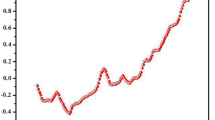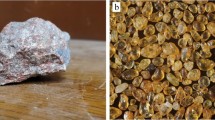Abstract
There are few feasible options for sorbents, which can be quickly manufactured and deployed in the event of a major oil spill and so every oil spill is an ecological disaster. This paper aims to provide an understanding of what a realistic, full-scale crude oil spill solution would look like based on the performance of the best sorbents currently available, their costs, and their advantages.
Adsorbent materials or “sorbents” described here have been a recent target for research toward applications in environmental cleanup, remediation, and hazardous material containment. These materials contain many compositions, syntheses, and practical manufacturing parameters that make most of them practically and logistically unfit to tackle quantities much larger than a single barrel of oil. Different properties of crude oil and nonpolar materials, such as their viscosity, density, and weathering, can also make these materials seem attractive on a lab scale but underperform in field testing and in practical applications. This review addresses the challenges, advantages, and disadvantages of different technical applications of the superior sorbent materials and material types in the literature. In addition, we discuss the different costs and manufacturing challenges of sorbent materials in real oil spills and what a feasible containment sorbent material might look like.











Similar content being viewed by others
Change history
01 July 2020
An Erratum to this paper has been published: https://doi.org/10.1557/mre.2020.14
References
Guard U.C.: Coordinator Report Deepwater Horizon (National Oceanic and Atmospheric Administration, Silver Spring, MD, 2011).
Ivshina I.B., Kuyukina M.S., Krivoruchko A.V., Elkin A.A., Makarov S.O., Cunningham C.J., Peshkur T.A., and Atlas M.: Environmental science processes & impacts oil spill problems and sustainable response strategies through new technologies 33(0), 1201–1219 (2015).
Schrope M.: Oil spill: Deep wounds. Nature 472, 152–154 (2011).
Wilson M., Graham L., Hale C., Maung-Douglass E., Sempier S., Skelton T., and Swann L.: Oil spill science: Deepwater horizon-where did the oil go? 1–8 (2017). Available at: https://protect-eu.mimecast.com/s/pIaTCNOBOsNX6E1TRFv8t?domain=masgc.org.
Graham L.J., Hale C., Maung-douglass E., and Sempier S.: Chemical dispersants and their role in oil spill response (2016). Available at: https://protect-eu.mimecast.com/s/4-PVCOgDgsA4O0oUPQiLn?domain=masgc.org.
Walther H.R.: Clean up Techniques Used for Coastal Oil Spills: An Analysis of Spills Occurring in Santa Barbara, California, Prince William Sound, Alaska, the Sea of Japan, and the Gulf Coast (University of San Francisco, San Francisco, CA, 2014).
Oil Tanker Spill Statistics 2017, 2018.
Chang S.E., Stone J., Demes K., and Piscitelli M.: Consequences of oil spills: A review and framework for informing planning. Ecol. Soc. 19(2), 26 (2014).
Goodbody-Gringley G., Wetzel D.L., Gillon D., Pulster E., Miller A., and Ritchie K.B.: Toxicity of Deepwater Horizon source oil and the chemical dispersant, Corexit® 9500, to coral larvae. PLoS One 8(1), 1–10 (2013).
Evans D.D., George W., Baum H.R., Walton W.D., and Kevin B.: In situ burning of oil spills. J. Res. Natl. Inst. Stand. Technol. 106(1), 231–278 (2001).
Korsh J., Shen A., Aliano K., and Davenport T.: Polycyclic aromatic hydrocarbons and breast cancer: A review of the literature. Breast Care 10(5), 316–318 (2015).
Khordagui H.: Environmental impact of the Gulf war: An integrated preliminary assessment. Environ. Manage. 17(4), 557–562 (1993).
Barry E., Mane A.U., Libera J.A., Elam J.W., and Darling S.B.: Advanced oil sorbents using sequential infiltration synthesis. J. Mater. Chem. A 5, 2929–2935 (2017).
Nelson J.R. and Grubesic T.H.: Oil spill modeling: Risk, spatial vulnerability, and impact assessment. Prog. Phys. Geogr. 42(1), 112–127 (2018).
Ainsworth C.H., Paris C.B., Perlin N., Dornberger L.N., Patterson W.F., III, Chancellor E., Murawski S., Hollander D., Daly K., Romero I.C., Coleman F., and Perryman H.: Impacts of the Deepwater Horizon oil spill evaluated using an end-to-end ecosystem model. PLoS One 13(1), e0190840 (2018).
Bishop R.C., Boyle K.J., Carson R.T., Chapman D., Michael W., Kanninen B., Kopp R.J., Krosnick J.A., List J., Paterson R., Presser S., Smith V.K., Tourangeau R., Welsh M., Wooldridge J.M., Debell M., Donovan C., Konopka M., and Scherer N.: Putting a value on injuries to natural assets: The BP oil spill. Science 356(6335), 253–254 (2017).
Sabir S.: Approach of cost-effective adsorbents for oil removal from oily water. Crit. Rev. Environ. Sci. Technol. 45(17), 1916–1945 (2015).
Doshi B., Sillanpää M., and Kalliola S.: A review of bio-based materials for oil spill treatment. Water Res. 135, 262–277 (2018).
Du F., Huang J., Duan H., Xiong C., and Wang J.: Wetting transparency of supported graphene is regulated by polarities of liquids and substrates. Appl. Surf. Sci. 454(May), 249–255 (2018).
Chandler D.: Interfaces and the driving force of hydrophobic assembly. Nature 437(7059), 640–647 (2005).
Dedov A.G., Ivanova E.A., Sandzhieva D.A., Lobakova E.S., Kashcheeva P.B., Kirpichnikov M.P., Ishkov A.G., and Buznik V.M.: New materials and ecology: Biocomposites for aquatic remediation. Theor. Found. Chem. Eng. 51(4), 617–630 (2017).
Liu S., Xu Q., Latthe S.S., Gurav A.B., and Xing R.: Superhydrophobic/superoleophilic magnetic polyurethane sponge for oil/water separation. RSC Adv. 5(84), 68293–68298 (2015).
Langevin D., Poteau S., Hénaut I., and Argillier J.F.: Crude oil emulsion properties and their application to heavy oil transportation. Oil Gas Sci. Technol. 59(5), 511–521 (2004).
Liu Y. and Kujawinski E.B.: Chemical composition and potential environmental impacts of water-soluble polar crude oil components inferred from esi FT-ICRMS. PLoS One 10(9), 1–18 (2015).
Meyer R.F., Attanasi E.D., and Freeman P.A.: Heavy Oil and Natural Bitumen Resources in Geological Basins of the World (U.S. Geological Survey, Reston, VA, 2007).
Gibson L.J. and Ashby M.F.: Cellular Solids: Structure and Properties, 2nd ed. (Cambridge University Press, Cambridge, England, 1997).
Pang Y., Wang S., Wu M., Liu W., Wu F., Lee P.C., and Zheng W.: Kinetics study of oil sorption with open-cell polypropylene/polyolefin elastomer blend foams prepared via continuous extrusion foaming. Polym. Adv. Technol. 29(4), 1313–1321 (2018).
Bay H.: Design, Synthesis and Characterization of Novel Graphene-Based Nanoarchitectures for Sustainability (University of California Riverside, Riverside, CA, 2015).
Bay H.H., Patino D., Mutlu Z., Romero P., Ozkan M., and Ozkan C.S.: Scalable multifunctional ultra-thin graphite sponge: Free-standing, superporous, superhydrophobic, oleophilic architecture with ferromagnetic properties for environmental cleaning. Sci. Rep. 6, 21858 (2016).
Ethington E.F.: Interfacial contact angle measurements of water, mercury, and 20 organic liquids on quartz, calcite, biotite, and Ca-montmorillonite substrates. United States Geol. Surv. 90–409(July), 1–18 (1990).
Shtein Z. and Shoseyov O.: When bottom-up meets top-down. Proc. Natl. Acad. Sci. U. S. A. 114(3), 428–429 (2017).
Zhang L., Xu L., Sun Y., and Yang N.: Robust and durable superhydrophobic polyurethane sponge for oil/water separation. Ind. Eng. Chem. Res. 55(43), 11260–11268 (2016).
Abbasi Z., Shamsaei E., Fang X.Y., Ladewig B., and Wang H.: Simple fabrication of zeolitic imidazolate framework ZIF-8/polymer composite beads by phase inversion method for efficient oil sorption. J. Colloid Interface Sci. 493, 150–161 (2017).
Suh D.J., Park T.J., Han H.Y., and Lim J.C.: Synthesis of highsurface-area zirconia aerogels with a well-developed mesoporous texture using CO2 supercritical drying. Chem. Mater. 14(4), 1452–1454 (2002).
Jambeck J.R., Geyer R., Wilcox C., Siegler T.R., Perryman M., Andrady A., Narayan R., and Law K.L.: Plastic waste inputs from land into the ocean. Science 347(6223), 768–771 (2015).
Koelmans A.A., Gouin T., Thompson R., Wallace N., and Arthur C.: Plastics in the marine environment. Environ. Toxicol. Chem. 33(1), 5–10 (2014).
Mohan D., Sarswat A., Ok Y.S., and Pittman C.U.: Organic and inorganic contaminants removal from water with biochar, a renewable, low cost and sustainable adsorbent—A critical review. Bioresour. Technol. 160(October), 191–202 (2014).
Crini G.: Review: A history of cyclodextrins. Chem. Rev. 114(21), 10940–10975 (2014).
Wang S., Dai G., Yang H., and Luo Z.: Lignocellulosic biomass pyrolysis mechanism: A state-of-the-art review. Prog. Energy Combust. Sci. 62, 33–86 (2017).
Adebajo M.O., Frost R.L., Kloprogge J.T., Carmody O., and Kokot S.: Porous materials for oil spill cleanup: A review of synthesis. J. Porous Mater. 10, 159–170 (2003).
Nam C., Li H., Zhang G., and Chung T.C.M.: Petrogel: New hydrocarbon (oil) absorbent based on polyolefin polymers. Macromolecules 49(15), 5427–5437 (2016).
Guo Z., Gu H., Chen Q., He Z., Xu W., Zhang J., Liu Y., Xiong L., Zheng L., and Feng Y.: Macroporous monoliths with pH-induced switchable wettability for recyclable oil separation and recovery. J. Colloid Interface Sci. 534, 183–194 (2019).
Zhu Q., Pan Q., and Liu F.: Facile removal and collection of oils from water surfaces through superhydrophobic and superoleophilic sponges. J. Phys. Chem. C 115(35), 17464–17470 (2011).
Wang J. and Wang H.: Ultra-hydrophobic and mesoporous silica aerogel membranes for efficient separation of surfactant-stabilized water-in-oil emulsion separation. Sep. Purif. Technol. 212(November 2018), 597–604 (2019).
Wang D., McLaughlin E., Pfeffer R., and Lin Y.S.: Adsorption of oils from pure liquid and oil-water emulsion on hydrophobic silica aerogels. Sep. Purif. Technol. 99, 28–35 (2012).
Lv X., Tian D., Peng Y., Li J., and Jiang G.: Superhydrophobic magnetic reduced graphene oxide-decorated foam for efficient and repeatable oil-water separation. Appl. Surf. Sci. 466(October 2018), 937–945 (2019).
Wei Q., Oribayo O., Feng X., Rempel G.L., and Pan Q.: Synthesis of polyurethane foams loaded with TiO2 nanoparticles and their modification for enhanced performance in oil spill cleanup. Ind. Eng. Chem. Res. 57(27), 8918–8926 (2018).
Oribayo O., Feng X., Rempel G.L., and Pan Q.: Synthesis of lignin-based polyurethane/graphene oxide foam and its application as an absorbent for oil spill clean-ups and recovery. Chem. Eng. J. 323, 191–202 (2017).
Cao S., Dong T., Xu G., and Wang F.: Oil spill cleanup by hydrophobic natural fibers. J. Nat. Fibers 14(5), 727–735 (2017).
Bidgoli H., Mortazavi Y., and Khodadadi A.A.: A functionalized nano-structured cellulosic sorbent aerogel for oil spill cleanup: Synthesis MRS ENERGY & SUSTAINABILITY // VOLUME 6 // e3 // www.mrs.org/energy-sustainability-journal n 13 and characterization. J. Hazard. Mater. 366(November 2018), 229–239 (2018).
Wang Z., Saleem J., Barford J.P., Mckay G., Wang Z., Saleem J., Barford J.P., and Mckay G.: Preparation and characterization of modified rice husks by biological delignification and acetylation for oil spill cleanup. Environ. Technol., 1–12 (2018). Available at: https://protect-eu.mimecast.com/s/TX-rCMZAZC5WJRGCJOnc6?domain=tandfonline.com.
Zhang X., Wang C., Chai W., Liu X., Xu Y., and Zhou S.: Kapok fiber as a natural source for fabrication of oil absorbent. J. Chem. Technol. Biotechnol. 92(7), 1613–1619 (2017).
Singh V., Kendall R.J., Hake K., and Ramkumar S.: Crude oil sorption by raw cotton. Ind. Eng. Chem. Res. 52, 6277–6281 (2013).
Zhu Y., Romain C., and Williams C.K.: Sustainable polymers from renewable resources. Nature 540(7633), 354–362 (2016).
Wang X., Zhang Y., Zhi C., Wang X., Tang D., Xu Y., Weng Q., Jiang X., Mitome M., Golberg D., and Bando Y.: Three-dimensional strutted graphene grown by substrate-free sugar blowing for high-power-density supercapacitors. Nat. Commun. 4(May), 1–8 (2013).
Zhu Q., Chu Y., Wang Z., Chen N., Lin L., Liu F., and Pan Q.: Robust superhydrophobic polyurethane sponge as a highl y reusable oil-absorption material. J. Mater. Chem. A 1(17), 5386–5393 (2013).
Ge X., Yang W., Wang J., Long D., Ling L., and Qiao W.: Flexible carbon nanofiber sponges for highly efficient and recyclable oil absorption. RSC Adv. 5(86), 70025–70031 (2015).
Author information
Authors and Affiliations
Corresponding author
Rights and permissions
About this article
Cite this article
Patalano, A., Villalobos, F., Pena, P. et al. Scaling sorbent materials for real oil-sorbing applications and environmental disasters. MRS Energy & Sustainability 6, 3 (2019). https://doi.org/10.1557/mre.2019.3
Received:
Accepted:
Published:
DOI: https://doi.org/10.1557/mre.2019.3




